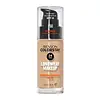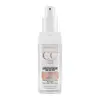What's inside
What's inside
 Key Ingredients
Key Ingredients

 Benefits
Benefits

 Concerns
Concerns

 Ingredients Side-by-side
Ingredients Side-by-side

Titanium Dioxide
Cosmetic ColorantZinc Oxide
Cosmetic ColorantCyclopentasiloxane
EmollientWater
Skin ConditioningDimethicone
EmollientTrimethylsiloxysilicate
EmollientPEG-9 Polydimethylsiloxyethyl Dimethicone
EmulsifyingButylene Glycol
HumectantTribehenin
EmollientPhenyl Trimethicone
Skin ConditioningNylon-12
Cymbidium Grandiflorum Flower Extract
Skin ConditioningLactobacillus/Eriodictyon Californicum Ferment Extract
Skin ConditioningLilium Candidum Bulb Extract
Skin ConditioningMalva Sylvestris Extract
AstringentSodium Hyaluronate
HumectantTocopheryl Acetate
AntioxidantBisabolol
MaskingEthylhexyl Palmitate
EmollientTocopherol
AntioxidantAlcohol Denat.
AntimicrobialAlumina
AbrasiveDimethicone/PEG-10/15 Crosspolymer
Methicone
EmollientLaureth-7
EmulsifyingMagnesium Sulfate
Silica
AbrasivePolyglyceryl-3 Diisostearate
EmulsifyingEthylene Brassylate
MaskingTriethoxycaprylylsilane
Dimethicone/Silsesquioxane Copolymer
PEG-12 Glyceryl Dimyristate
Skin ConditioningSalicylic Acid
MaskingSilk Powder
Skin ConditioningSodium Citrate
BufferingDipropylene Glycol
HumectantSilica Dimethyl Silylate
EmollientSerica
HumectantTetrasodium EDTA
Hexylene Glycol
EmulsifyingCaprylyl Glycol
EmollientPhenoxyethanol
PreservativeEthylparaben
PreservativeMethylparaben
PreservativeMica
Cosmetic ColorantIron Oxides
CI 77891
Cosmetic ColorantTitanium Dioxide, Zinc Oxide, Cyclopentasiloxane, Water, Dimethicone, Trimethylsiloxysilicate, PEG-9 Polydimethylsiloxyethyl Dimethicone, Butylene Glycol, Tribehenin, Phenyl Trimethicone, Nylon-12, Cymbidium Grandiflorum Flower Extract, Lactobacillus/Eriodictyon Californicum Ferment Extract, Lilium Candidum Bulb Extract, Malva Sylvestris Extract, Sodium Hyaluronate, Tocopheryl Acetate, Bisabolol, Ethylhexyl Palmitate, Tocopherol, Alcohol Denat., Alumina, Dimethicone/PEG-10/15 Crosspolymer, Methicone, Laureth-7, Magnesium Sulfate, Silica, Polyglyceryl-3 Diisostearate, Ethylene Brassylate, Triethoxycaprylylsilane, Dimethicone/Silsesquioxane Copolymer, PEG-12 Glyceryl Dimyristate, Salicylic Acid, Silk Powder, Sodium Citrate, Dipropylene Glycol, Silica Dimethyl Silylate, Serica, Tetrasodium EDTA, Hexylene Glycol, Caprylyl Glycol, Phenoxyethanol, Ethylparaben, Methylparaben, Mica, Iron Oxides, CI 77891
Titanium Dioxide 8.31%
Cosmetic ColorantEthylhexyl Methoxycinnamate 7.5%
UV AbsorberWater
Skin ConditioningCyclopentasiloxane
EmollientDimethicone
EmollientGlycerin
HumectantCyclohexasiloxane
EmollientMica
Cosmetic ColorantButylene Glycol
HumectantIsopropyl Myristate
EmollientPolymethylsilsesquioxane
Hexyl Laurate
EmollientCetyl PEG/PPG-10/1 Dimethicone
EmulsifyingPolyglyceryl-4 Isostearate
EmulsifyingBis-PEG/PPG-14/14 Dimethicone
EmollientDimethicone Crosspolymer
Emulsion StabilisingHdi/Trimethylol Hexyllactone Crosspolymer
Xylitylglucoside
HumectantDisteardimonium Hectorite
StabilisingAnhydroxylitol
HumectantSodium Chloride
MaskingDimethicone/Vinyl Dimethicone Crosspolymer
Skin ConditioningPropylene Glycol
HumectantAluminum Starch Octenylsuccinate
AbsorbentAlumina
AbrasiveAloe Barbadensis Leaf Juice
Skin ConditioningSucrose Dilaurate
EmollientXylitol
HumectantJojoba Esters
EmollientDiazolidinyl Urea
PreservativeSodium Benzoate
MaskingHydrolyzed Prunus Domestica
Skin ConditioningTalc
AbrasivePropylene Carbonate
SolventIsododecane
EmollientAcrylates/Dimethicone Copolymer
Skin ConditioningPotassium Sorbate
PreservativeCichorium Intybus Root Extract
MaskingGlucose
HumectantTriethoxycaprylylsilane
Phenoxyethanol
PreservativePolysorbate 20
EmulsifyingTocopheryl Acetate
AntioxidantBiosaccharide Gum-1
HumectantPisum Sativum Extract
Skin ConditioningCamellia Oleifera Leaf Extract
AstringentIsoceteth-10
EmulsifyingCaprylyl Glycol
EmollientMyristic Acid
CleansingP-Anisic Acid
MaskingEthylhexylglycerin
Skin ConditioningSorbic Acid
PreservativeIodopropynyl Butylcarbamate
PreservativeAlcohol
AntimicrobialChamomilla Recutita Flower Extract
MaskingCitric Acid
BufferingCI 77491
Cosmetic ColorantCI 77492
Cosmetic ColorantCI 77499
Cosmetic ColorantTitanium Dioxide 8.31%, Ethylhexyl Methoxycinnamate 7.5%, Water, Cyclopentasiloxane, Dimethicone, Glycerin, Cyclohexasiloxane, Mica, Butylene Glycol, Isopropyl Myristate, Polymethylsilsesquioxane, Hexyl Laurate, Cetyl PEG/PPG-10/1 Dimethicone, Polyglyceryl-4 Isostearate, Bis-PEG/PPG-14/14 Dimethicone, Dimethicone Crosspolymer, Hdi/Trimethylol Hexyllactone Crosspolymer, Xylitylglucoside, Disteardimonium Hectorite, Anhydroxylitol, Sodium Chloride, Dimethicone/Vinyl Dimethicone Crosspolymer, Propylene Glycol, Aluminum Starch Octenylsuccinate, Alumina, Aloe Barbadensis Leaf Juice, Sucrose Dilaurate, Xylitol, Jojoba Esters, Diazolidinyl Urea, Sodium Benzoate, Hydrolyzed Prunus Domestica, Talc, Propylene Carbonate, Isododecane, Acrylates/Dimethicone Copolymer, Potassium Sorbate, Cichorium Intybus Root Extract, Glucose, Triethoxycaprylylsilane, Phenoxyethanol, Polysorbate 20, Tocopheryl Acetate, Biosaccharide Gum-1, Pisum Sativum Extract, Camellia Oleifera Leaf Extract, Isoceteth-10, Caprylyl Glycol, Myristic Acid, P-Anisic Acid, Ethylhexylglycerin, Sorbic Acid, Iodopropynyl Butylcarbamate, Alcohol, Chamomilla Recutita Flower Extract, Citric Acid, CI 77491, CI 77492, CI 77499
Ingredients Explained
These ingredients are found in both products.
Ingredients higher up in an ingredient list are typically present in a larger amount.
Alumina is another name for the compound aluminum oxide. It is used as a thickener, absorbent, and abrasive.
As an absorbent, alumina can give a mattifying effect. It is used in mineral sunscreens to help coat nano-sized filters, such as titanium dioxide. By increasing the size of the UV filters, these ingredients stay on the skin for a longer time. By coating small sized ingredients, alumina helps thicken a product.
Alumina may be used as an abrasive, or exfoliant.
Alumina is naturally occurring in the mineral corundum. Certain varieties of corundum create rubies and sapphires. Corundum is also the crystalline form of alumina.
Learn more about AluminaButylene Glycol (or BG) is used within cosmetic products for a few different reasons:
Overall, Butylene Glycol is a safe and well-rounded ingredient that works well with other ingredients.
Though this ingredient works well with most skin types, some people with sensitive skin may experience a reaction such as allergic rashes, closed comedones, or itchiness.
Learn more about Butylene GlycolCaprylyl Glycol is a humectant and emollient, meaning it attracts and preserves moisture.
It is a common ingredient in many products, especially those designed to hydrate skin. The primary benefits are retaining moisture, skin softening, and promoting a healthy skin barrier.
Though Caprylyl Glycol is an alcohol derived from fatty acids, it is not the kind that can dry out skin.
This ingredient is also used as a preservative to extend the life of products. It has slight antimicrobial properties.
Learn more about Caprylyl GlycolCyclopentasiloxane, or D5, is a silicone used to improve texture of products and trap moisture.
D5 is considered lightweight and volatile. Volatile means it evaporates quickly after application. Once evaporated, D5 leaves a thin barrier that helps keep skin hydrated.
It is also an emollient. Emollients help soften the skin and prevent water loss. Silicones create a silky texture in products. D5 helps other ingredients become more spreadable.
Studies show D5 is safe to use in skincare products. We recommend speaking with a skincare professional if you have concerns.
Learn more about CyclopentasiloxaneDimethicone is a type of synthetic silicone created from natural materials such as quartz.
What it does:
Dimethicone comes in different viscosities:
Depending on the viscosity, dimethicone has different properties.
Ingredients lists don't always show which type is used, so we recommend reaching out to the brand if you have questions about the viscosity.
This ingredient is unlikely to cause irritation because it does not get absorbed into skin. However, people with silicone allergies should be careful about using this ingredient.
Note: Dimethicone may contribute to pilling. This is because it is not oil or water soluble, so pilling may occur when layered with products. When mixed with heavy oils in a formula, the outcome is also quite greasy.
Learn more about DimethiconeMica is a naturally occurring mineral used to add shimmer and color in cosmetics. It can also help improve the texture of a product or give it an opaque, white/silver color.
Serecite is the name for very fine but ragged grains of mica.
This ingredient is often coated with metal oxides like titanium dioxide. Trace amounts of heavy metals may be found in mica, but these metals are not harmful in our personal products.
Mica has been used since prehistoric times throughout the world. Ancient Egyptian, Indian, Greek, Roman, Aztec, and Chinese civilizations have used mica.
Learn more about MicaPhenoxyethanol is a preservative that has germicide, antimicrobial, and aromatic properties. Studies show that phenoxyethanol can prevent microbial growth. By itself, it has a scent that is similar to that of a rose.
It's often used in formulations along with Caprylyl Glycol to preserve the shelf life of products.
Titanium dioxide is a mineral UV filter widely used in sunscreens and cosmetics.
It is one of only two UV filters officially classified as “mineral” by regulatory agencies, the other being zinc oxide.
Titanium dioxide provides broad-spectrum protection mostly in the UVB and UVAII range, with some protection in the UVAI range.
While its UVA protection isn’t as strong as zinc oxide’s, the difference is minor.
A common myth is that mineral UV filters reflect UV light. However, modern research shows titanium dioxide absorbs UV radiation like chemical filters (~95% absorption & 5% reflection).
Thanks to its non-irritating nature, titanium dioxide is suitable for sensitive, acne-prone, or redness-prone skin. It is unlikely to cause "eye sting" like other sunscreen ingredients.
A major drawback of this ingredient is its white cast and thick texture. This is why mineral sunscreens often leave a white cast and are less cosmetically elegant than chemical/hybrid sunscreens.
To improve white cast and spreadability, micronized or nano-sized titanium dioxide is often used.
There are ongoing concerns surrounding nano-titanium oxide's impact on marine ecosystems.
There is no conclusive evidence that any form of titanium oxide (or any other sunscreen ingredients) will cause harm to marine ecosystems or coral reefs. The science is still developing but many consumers are keeping a close eye on this issue.
Please note, many destinations have reef-safety sunscreen rules. For instance, the U.S. Virgin Islands advises all visitors to use non-nano mineral sunscreens.
Nano mineral sunscreens once raised safety concerns about absorption into skin.
Extensive research has shown that they do not penetrate healthy or damaged skin; they remain safely on the surface and the top layer of dead skin (stratum corneum).
You'll likely find titanium dioxide bundled with alumina, silica, or dimethicone. These ingredients help make titanium dioxide highly photostable; this prevents it from interacting with other formula components under UV light.
Learn more about Titanium DioxideTocopheryl Acetate is AKA Vitamin E. It is an antioxidant and protects your skin from free radicals. Free radicals damage the skin by breaking down collagen.
One study found using Tocopheryl Acetate with Vitamin C decreased the number of sunburned cells.
Tocopheryl Acetate is commonly found in both skincare and dietary supplements.
Learn more about Tocopheryl AcetateTriethoxycaprylylsilane is a silicone used to bind and stabilize ingredients.
As an emulsifier, it helps prevent ingredients from separating. This can help elongate the shelf life of products.
Triethoxycaprylylsilane is often used to coat mineral sunscreens ingredients to help give a better feel. It also helps reduce oxidative stress in sunscreens.
Learn more about TriethoxycaprylylsilaneWater. It's the most common cosmetic ingredient of all. You'll usually see it at the top of ingredient lists, meaning that it makes up the largest part of the product.
So why is it so popular? Water most often acts as a solvent - this means that it helps dissolve other ingredients into the formulation.
You'll also recognize water as that liquid we all need to stay alive. If you see this, drink a glass of water. Stay hydrated!
Learn more about Water